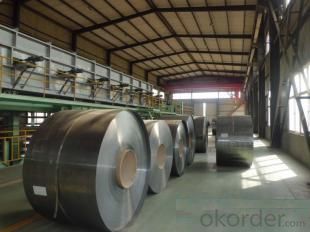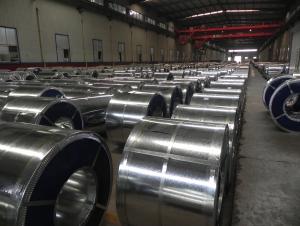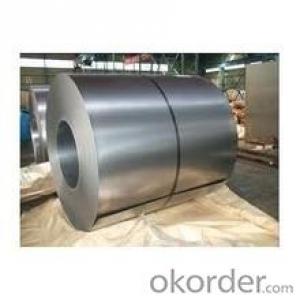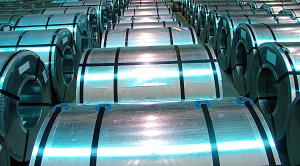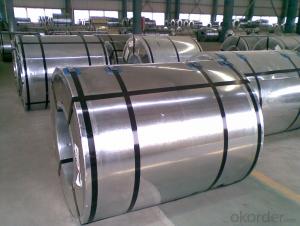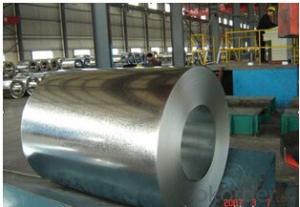GALVANIZED STEEL COIL
- Loading Port:
- China Main Port
- Payment Terms:
- TT OR LC
- Min Order Qty:
- -
- Supply Capability:
- 10000 m.t./month
OKorder Service Pledge
Quality Product, Order Online Tracking, Timely Delivery
OKorder Financial Service
Credit Rating, Credit Services, Credit Purchasing
You Might Also Like
HOT-DIP GALVANIZED STEEL COIL
SIZE:0.2mm*1000mm*C
ZINC COATING:60g/m2
STANDARD:JIS G 3302
SURFACE:CHROMATED,REGULAR SPANGLE, UNOILED
STEEL GRADE:SGCC
COIL WEIGHT:3-6 ton
COIL ID:508mm
- Q: why do you need to heat steel when hardening, molecules etc etc
- Heat treatment deforms the crystal micro structure of the Steel. With heat (and cold) treatment the organisation or Diffusion of the micro particles can be manipulated. There is a higher concentration of particles after heat treatment, thus making the micro structure of the steel more dense, and the physical performance of the steel better. Stronger. Hope this helps ! Please like.
- Q: in a lab at school we did heat treatment of steelwhat are the possible phases present in the steel sample in as-received, as-quenched and as-tempered conditions? specifically when is it ferrite, austenite and pearliteis the steel originally in the ferrite phase? then when headed turns into austenite and when quenched martensite is formed and when tempered cermentite is formed...........where is pearlite involved and am i correct about the ferrite?
- hey from what i learned in uni last sem, steel is originally ferrite form at first at room conditions. it will undergo poly morphic transformation to become FCC structure austenite form at 912 degree celcius. under conditions, it can become pearlite (which is a combination of ferrite and cementite) or bainitie( a finer form of pearlite). queching conditions to room temperature will form martensite which is the strongest but brittle steel form. tempered cementite is formed when we quench it and then raise temperatures before sir cooling. hope it helps, pls vote me best answer is i deserve it. thanks
- Q: What are the common methods of packaging steel coils for international shipping?
- There are several common methods of packaging steel coils for international shipping. These methods are designed to ensure the safety and security of the coils during transit. One method is the use of wooden crates. The steel coils are placed on wooden pallets and secured with steel bands or straps. The coils are then covered with wooden boards or plywood and nailed or screwed in place to create a sturdy crate. This method provides excellent protection against damage and ensures that the coils remain in place during transportation. Another method is the use of steel frames or skids. The steel coils are placed on steel skids or frames that are designed to support the weight and shape of the coils. The coils are then secured to the skids or frames with steel bands or straps. This method offers a high level of stability and protection, and is commonly used for larger or heavier coils. In addition to wooden crates and steel frames, steel coils can also be packaged using steel containers or shipping containers. These containers are specially designed to transport heavy or bulky items and provide a secure and protective environment for the coils. The coils are loaded into the container and secured with steel bands or straps to prevent movement during transit. Regardless of the packaging method used, it is important to ensure that the steel coils are properly protected from moisture, corrosion, and other potential hazards. This may involve the use of moisture-resistant materials such as plastic or wax paper, as well as the application of protective coatings or wraps. Overall, the common methods of packaging steel coils for international shipping include wooden crates, steel frames or skids, and steel containers. These methods are chosen based on the size, weight, and specific requirements of the coils, and aim to provide maximum protection and security during transit.
- Q: How are steel coils used in the manufacturing of metal containers?
- Steel coils are used in the manufacturing of metal containers as they are typically unrolled and cut into specific sizes and shapes to form the body of the container. These steel coils provide strength and durability to the containers, making them suitable for storing various products such as food, beverages, chemicals, and more.
- Q: What are the different methods of painting steel coils?
- There are several different methods of painting steel coils, each with its own advantages and applications. 1. Coil coating: This is a continuous and automated process where a coil of steel is unwound, cleaned, pretreated, primed, painted, and cured before being rewound. Coil coating offers excellent control over the paint application and ensures a consistent finish. It is commonly used for high-volume production of steel coils, such as in the automotive and construction industries. 2. Spray painting: This method involves manually or mechanically spraying paint onto the steel coils. It is a versatile and flexible method that allows for customization and precise control over the paint application. Spray painting can be done in various ways, such as airless spraying or electrostatic spraying, depending on the desired finish and the specific requirements of the project. 3. Dip coating: Also known as immersion coating, this method involves immersing the steel coils into a tank of paint. The coils are carefully lowered into the paint, ensuring that all surfaces are fully coated. Dip coating is often used for large or bulky steel coils that cannot be easily spray painted. It provides excellent coverage and can be suitable for certain applications, such as in the electrical or appliance industry. 4. Powder coating: This method involves applying a dry powder paint to the steel coils using an electrostatic process. The charged powder particles adhere to the grounded coils, creating a durable and even coating. Powder coating offers excellent resistance to impact, chemicals, and UV rays. It is commonly used in applications where a high-quality and long-lasting finish is required, such as in the aerospace or outdoor equipment industry. 5. Roll coating: This method involves passing the steel coils through a series of rollers that are partially submerged in paint. As the coils go through the rollers, the paint is transferred onto their surface. Roll coating is often used for thin or delicate steel coils, as it provides a gentle and uniform paint application. It is commonly used in the appliance or electronics industry. Each method has its own advantages and is chosen based on factors such as the desired finish, production volume, cost, and specific requirements of the project. Ultimately, the choice of painting method depends on finding the most suitable balance between quality, efficiency, and cost-effectiveness.
- Q: Can steel coils be used in the manufacturing of machinery and equipment?
- Yes, steel coils can be used in the manufacturing of machinery and equipment. Steel coils have high strength and durability, making them suitable for various applications in the machinery and equipment industry. They can be shaped, cut, and formed into various components, such as frames, shafts, gears, and structural parts, to meet the specific requirements of different machinery and equipment. Additionally, steel coils can be further processed and treated to enhance their properties, such as through heat treatment or surface coatings, to improve their performance and longevity in the manufacturing process.
- Q: Is there a type of spray paint that would work on Stainless steel?That would also be permenant or at least make it through a wash or two?
- I've also learned something today! Good luck and have fun!
- Q: steel can be used to do?
- Stainless steel can be used to (1) industrial use stainless steel (2) building decoration use stainless steel;(3) medical equipment (4) life with stainless steel tableware and the Jawaysteel is a great Chinese company, offer various kinds of stainless steel Maybe you can to their advice
- Q: I would like to build steel galvanization plant.
- Galvanising Plant
- Q: nylon sounds alot better but i want to keep the acoustic i have now. Is it proper to put nylon on an acoustic guitar meant for steel strings?
- Nylon Strings For Acoustic Guitar
Send your message to us
GALVANIZED STEEL COIL
- Loading Port:
- China Main Port
- Payment Terms:
- TT OR LC
- Min Order Qty:
- -
- Supply Capability:
- 10000 m.t./month
OKorder Service Pledge
Quality Product, Order Online Tracking, Timely Delivery
OKorder Financial Service
Credit Rating, Credit Services, Credit Purchasing
Similar products
Hot products
Hot Searches
Related keywords





